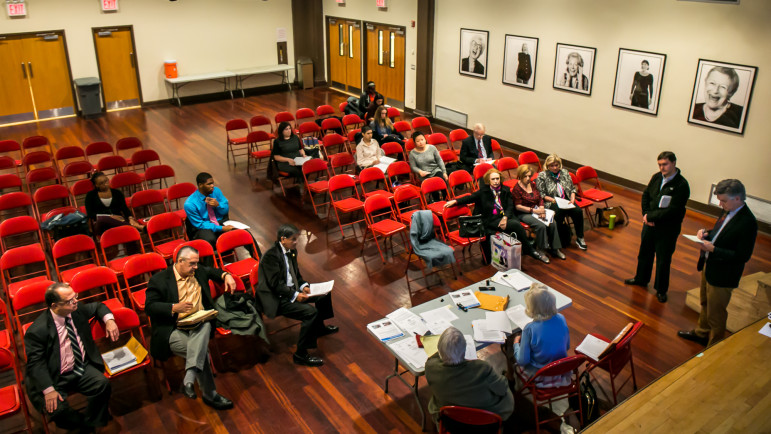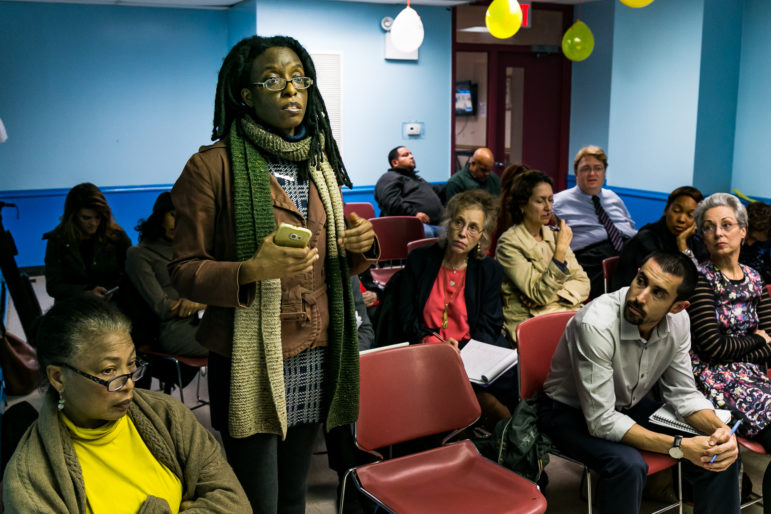“Community Boards are currently being asked to do more with less,” wrote a task force of district managers and administrative staffers in a report released last month. “Especially in the last year-and-a-half, community boards have been on the frontlines of the COVID-19 crisis.”

Applications are currently open for New York City’s 59 community boards, but a new report says the freshman members shouldn’t be the only change to the local nodes of democracy.
District managers and community board staffers from all five boroughs have outlined how to make the boards stronger, smarter and more accessible as they weigh in on key land use and budgeting decisions—from neighborhood-level rezonings to liquor licenses.
The Future of New York City’s Community Boards working group says it all starts with more money to meet requirements outlined in a 2018 city charter revision.
“Community Boards are currently being asked to do more with less,” wrote a task force of district managers and administrative staffers in a report released last month. “Especially in the last year-and-a-half, community boards have been on the frontlines of the COVID-19 crisis.”
The task force, made up of district managers and staff from 28 boards citywide, urged the city to pay for technology upgrades that will make meetings more accessible, fund a city planner for each board and require consistent training for members, especially when it comes to conflicts of interest and the complexities of land use rules.
They noted that some board members have little understanding of the zoning issues they are supposed to vote on. Other members have unreported conflicts of interest as they weigh in on housing and land use matters, the report added.
The start of a new mayoral administration and City Council class provides “an opportunity to strengthen the collaborative relationship between the community boards and all the elected officials and agency staff with whom they interact,” the working group wrote.
Community boards serve as key conduits between local neighborhoods and city government. All members are appointed by their borough president and up to half are recommended by their councilmember. Each community board is made up of up to 50 unpaid representatives who live in, work in or have some connection to the district. New York City community districts range in population from 50,000 people to roughly 200,000—more than the entire population of Birmingham, Alabama or Akron, Ohio, the report notes.
Modern community boards were created in 1968 in response to demands for more representative local democracy. The city charter, which established the current 59-community-district structure in 1975, has empowered the boards to cast advisory votes on land use applications, submit a local needs assessment during the budgeting process and host forums on pressing community issues. They meet at least monthly, except in July and August, and are led by an elected chair. Each board also includes various committees, like land use, that meet for additional public sessions.
But it’s the district managers and administrative staff, paid city employees, who labor behind the scenes to keep things running smoothly—or not so smoothly, according to the report. The task force was led by Celestina León, district manager for Brooklyn Community Board 4 (Bushwick), and Susan Stetzer, district manager for Manhattan Community Board 3 (Chinatown, Lower East Side).
The working group said current city funding levels— $231,100 for staff and less than $27,000 for things like office supplies and mailing costs—has left them unable to hire more employees, seek digital training or upgrade their communication technology. That has hindered access over the last two years, as the COVID-19 pandemic forced community boards to operate remotely.
The city has not significantly increased community board operating budgets since 2014.
A handful of boards in wealthier communities have fundraised through non-profit organizations—a necessary arrangement, the report’s authors wrote, citing the experience of Brooklyn’s Community Board 6.

Adi Talwar
A meeting of East Harlem Community Board 11’s Land Use, Landmarks & Planning Committee back in 2016, weighing in on the neighborhood’s rezoning plan under consideration at the time.“At current levels of City funding, CB6’s District Office chronically lags in its ability to keep up with the demands of the Board’s work,” they said. “Proactive planning and long-term thinking are rare privileges for an organization that is mandated to represent and advocate for the varied needs of its neighborhoods.”
The extra money has helped Brooklyn’s CB6—which represents Park Slope, Carroll Gardens, Cobble Hill, Columbia Waterfront, Gowanus, Park Slope and Red Hook—archive meeting videos online. They and other boards, like Central Queens’ Community Board 6, have also embraced social media to promote membership, upcoming hearings and additional local issues.
Other boards have not adapted so well to the digital demands.Tech training and IT assistance would go a long way, the working group said.
No issue garners more attention for community boards than their advisory decisions on land use issues, including neighborhood-level rezonings put forth by the Department of City Planning. Yet, it’s also an area some members know little about.
“While many members are deeply engaged in their responsibilities, others are either disconnected from the board’s work, or lack the tools they need for success,” the report states.
District managers who participated in the working group said some members seem “wholly unfamiliar with the work and processes of community boards,” suggesting that their appointments were purely political considerations from a borough president.
“Why would you join something about which you have no direct knowledge?” one district manager responded.
A 2018 charter revision mandated that the city provide training to board members, but in practice that has not been the case.
The working group recommended that borough presidents require prospective members to at least attend board meetings before their appointment, and called on the city to require training on zoning and land use, meeting procedures and conflicts of interest.
“We have always been small but mighty, accomplishing a lot with a little,” the report states. “However, as the city emerges from the COVID-19 pandemic, it has become even more clear that the resources provided are insufficient for us to effectively carry out our responsibilities, including our critical role on the frontlines of managing both local and citywide crises.”










8 thoughts on “District Managers Call on NYC to Boost Budgets for Community Boards”
The Community Board system is not perfect, but it’s still better to have Community Boards because they give local neighborhoods a voice over what is to happen in their own communities.
‘…to require training on zoning and land use…’
That might make sense.
Community boards should he eliminated. District managers are political hires that ignore the community and serve the whims of 45 plus community board members who act in their own interest with conflict of interest .
Bronx community board 11 is a ceasepool
In my opinion, Community Board 11 in the Bronx is neither a ceasepool, or
a cesspool. I agree that the members of all Community Boards in general, are more likely to support the wishes of the elected representatives who have placed them on the Board. I do believe that the vast majority of the Board member’s votes & decisions are more often driven by the available information presented to them, combined with the articulated input of the affected community. I would point out that the information provided by Community Board 10 here in the Bronx, has helped give the Co-op City Board of Directors, and our community at large, the opportunity to appropriately respond to action(s) being proposed which in our opinion, negatively impacted the Co-op City community.
NOPE, Bronx Community Board 11 is a ceasepool and the DM and many of the community board members should be removed IMMEDIATELY. Acting in their own self interest. Either eliminate the community board or make the district manager position an electable one.
Community Boards serve an incredibly important function. The City does not operate or plan based on ground up but more on top donor down. The voice of the community is gone without CBs. Even if there is 1 bad apple, don’t throw the entire basket out. DMs are an employee of the city and is there to support the Board not drive their own agendas – definitely should not be an electable position beholden to donors.
I dont think the community board serve the community. Community board 11 aint did anything for the neighborhood of bath beach bklyn for years .what they now get paid to do nothing. Massive System Failure.
I dont think the community board serve the community. Community board 11 aint did anything for the neighborhood of bath beach bklyn for years .what they now get paid to do nothing. Massive System Failure.
Community Boards can be a critical part of the delivery of services and development projects in neighborhoods/ communities. Are changes needed absolutely, from better training for members, to providing an increase in funds for operations. Individuals that apply for membership on these Boards all have a desire to serve their communities.
Their is some concern as to selection of District Managers, but that can and should be addressed. Community Boards ultimately are a vehicle for the residents of neighborhoods/ community to have input in decisions that affect their families in direct ways.